
Saccharina latissima
Sugar Kelp
Observations conducted: 26 June 2021, (start time 1:30pm PDT)
Kye Bay, Strait of Georgia, B.C., Canada.
Tide: 0.0 foot tide 13:37pm PDT (measured at Little River Tidal Station)
Conditions: Clear, no precipitation, wind calm, sea smooth, 26˚C.
Phase of Moon: Waning Gibbous (approx. 2 days into this phase at time of interaction); (Previous Phase, Full Moon, 24 June 2021 at 11:39am PDT: Next Phase, Third Quarter, 1 July 2021 at 2:10pm PDT.)
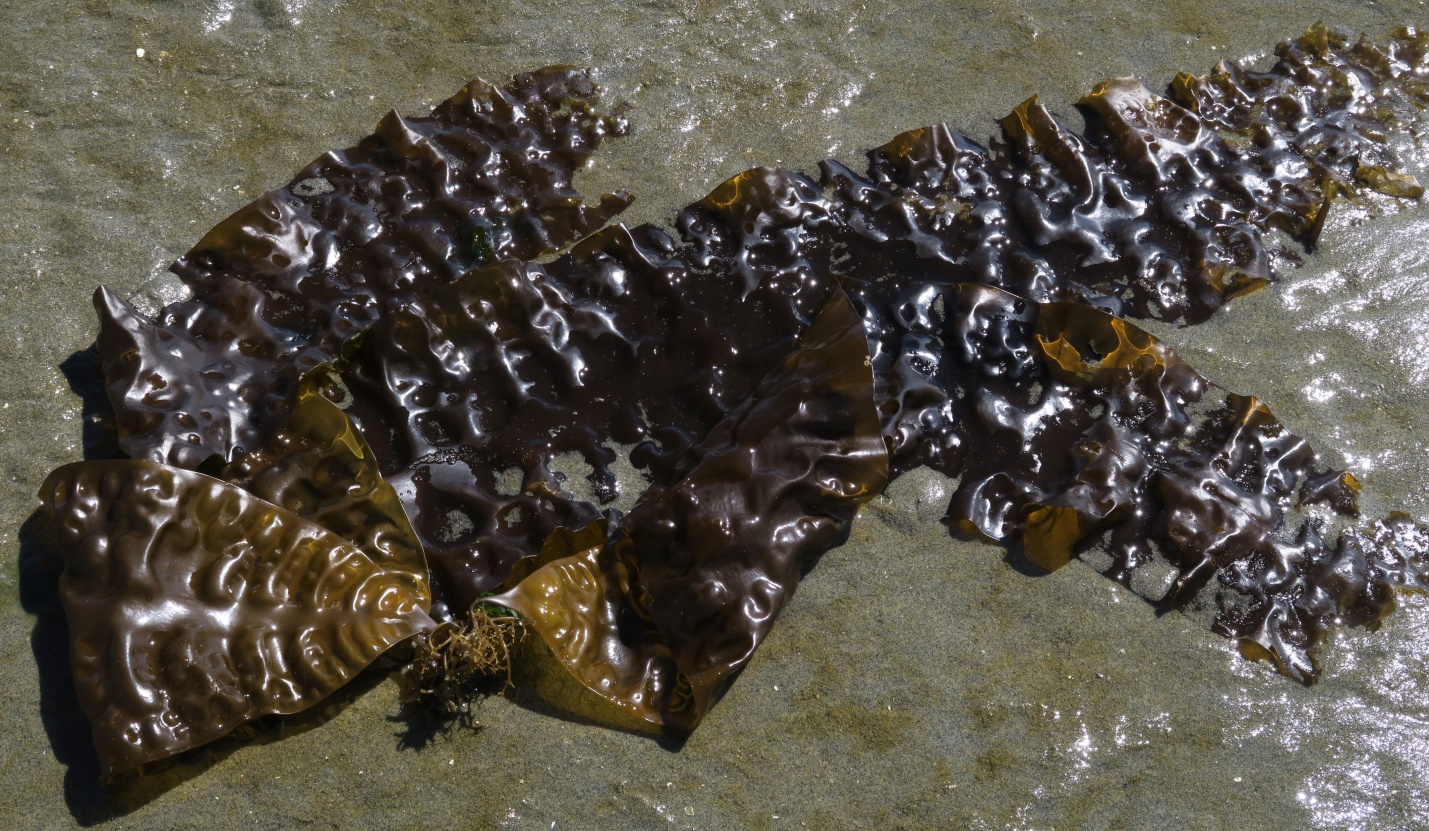
Figure 1: Saccharina latissima, Sugar Kelp, several blades complete with their holdfast are seen washed ashore on this sandy section of coastline. Point Holmes, Strait of Georgia, B.C. Canada. June 25, 2021. Photo ID 27321 ©Seaweedwhisperings.com
Person 1:
Quite a few large specimens, most of them detached, wallowing in a drain channel.
Some up to 3 meters in length.
Small holdfast with many haptera.
Blade purple-y black to dark olive, smooth edges, overall rippled appearance. Smooth broad center to the blade with a wide row of bullae on either side.
I did see paler colored specimens but was not attracted to them and walked right on by.
Blade is randomly indented with bullae on both sides.
Blade looks tough, feels tough and thick.
Blade texture is very rubbery.
Looks like you want to be left alone. Reluctantly allows interaction.
Blade appearance looks like a fine smooth leather, contrasts with its rubber feel.
Seems relatively un-grazed. Wonder if it swats away the grazers.
“Go away, leave me alone”.
I’ve long been attracted to this species but it hasn’t “allowed” interaction previously. We see this seaweed on almost every beach we visit.
Indifferent…, standoffish…, uninviting.
Perhaps it teases or taunts, attracting then disappointing.
‘Disappoints’ by giving nothing, leaving you empty and unsatisfied.
Poor / weak attachment to the material world.
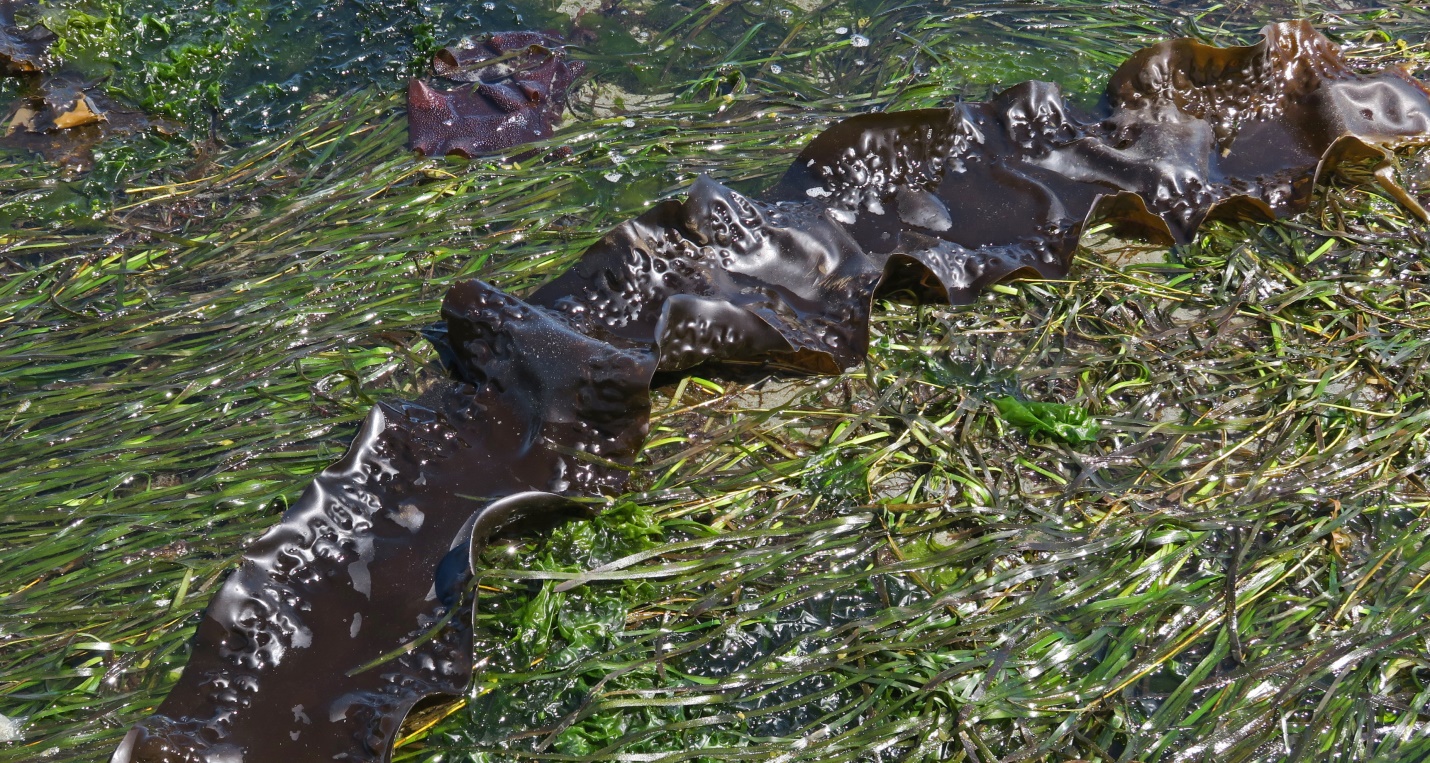
Figure 2: Saccharina latissima – one large Sugar Kelp blade beached atop a bed of eelgrass. Kye Bay, Strait of Georgia, B.C., Canada. June 26, 2021. Photo ID 27322 ©Seaweedwhisperings.com
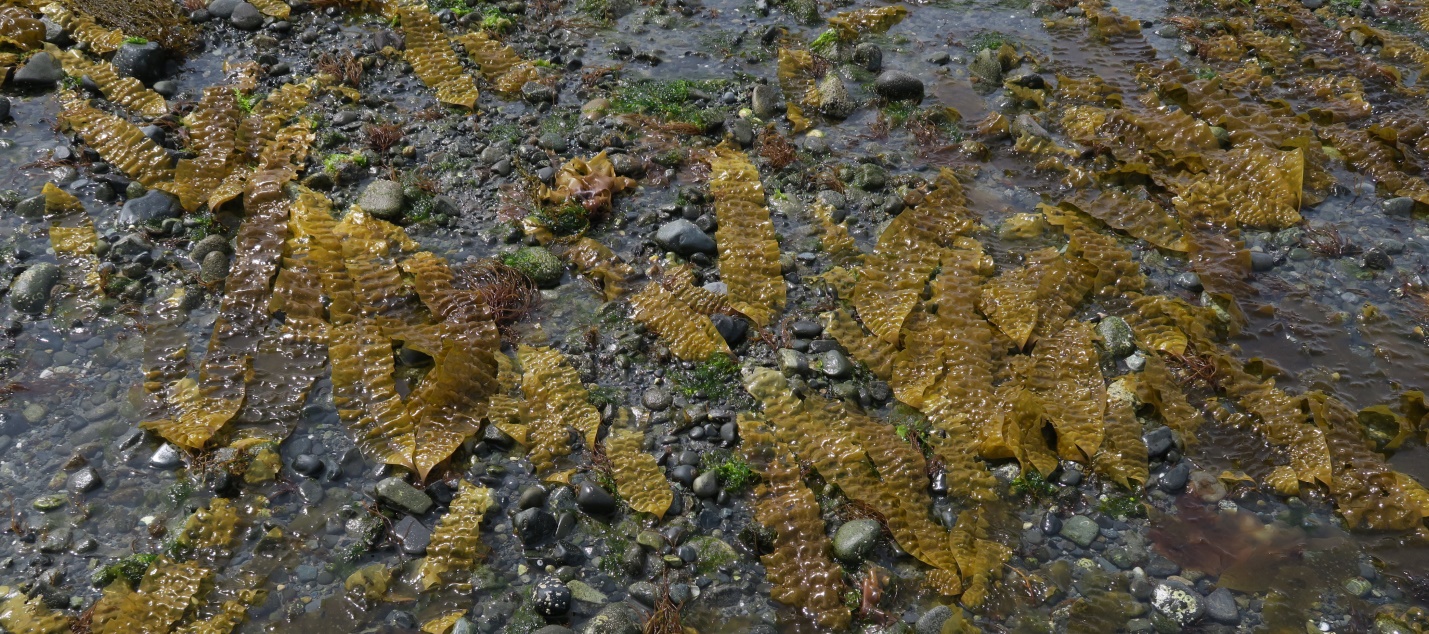
Figure 3: A species that can colonize and flourish in areas with unstable substrata, seen here is a large community of Sugar Kelp growing on an extensive cobble and gravel beach. The golden color is probably indicative of low nutrients and possibly too much sunlight – this seaweed is highly light sensitive. Little Qualicum River Estuary, Strait of Georgia, BC. April 29, 2021. Photo ID 27323 ©Seaweedwhisperings.com
Person 2:
Massive blades here on this extensive sandy beach.
Some are 2 or 3 meters long and 35 cm wide.
You’re torn from your substrate like you never were all that well attached.
The branches (haptera) of your holdfast look intact – so why did you break away?
Every blade I find here (and there are numerous ones) have their holdfast attached.
Poor connection and then possibly also not knowing when to hold on and when to let go?
You live whole and die whole.
An annual?
Grows fast.
Some holes are eaten in you. Are you too sweet and tasty to resist?
Your textured blade gives interest to a rather simple overall shape.
Texture catches light and creates some shadow.
Sugar Kelp, your color reminds me of caramel and maple syrup, of the warm and rich browns of melted cane SUGAR that is starting to burn.
Yes, I think that is it; you can’t stand too much heat. You can’t withstand the flames of discord and you wilt under too much pressure – actually it doesn’t take too much aggressive force for you to give up and give way entirely. Discord melts any resolve you’ve managed to build up.
Touching some of the blades here that are exposed at low tide, there is a stickiness on the surface. It’s actually unpleasant to handle the blade and to experience this alga ‘sticking’ to my fingers – I want to drop it and wash my hands. I’m not inclined to touch it again. I do NOT want it ‘stuck’ to me!
I tasted a piece from a smaller Sugar Kelp – it looked to be younger and was lighter in color. But at this season maybe you’re all tougher. It was not simple to break off a piece.
Taste was not pleasant, not unpleasant – I rejected it, spat it out.
Disappointing – hype is more than the reality, perhaps.
I tested a darker brown blade that was much larger. It took much strength to rip your margin, but once I broke through the margin you tore very easily.
Sugar Kelp, are you a tease?
Do you promise more than you actually can deliver?
Do you try to be strong to meet the world but do you also know (and do others who look more closely find) that inside you are as soft as a marshmallow?
Do you recognize that your ‘hold’ or anchor is quite tenuous and weak? That perhaps it is even designed to let go under certain circumstances?
Golden warm tones of caramel and rich browns. You have a look that is sunny and warm and generous.
It calls me to come closer, but when I get up close, I’m not as entranced. I see your pitfalls and your limitations your shadows and ups and downs. You still impress, but now it’s in an unpleasant way; I’m repelled.
I feel deceived – did you change personas? Are you a Dr. Jekyll and Mr. Hyde personality? Do you have this kind of unpredictable dual nature? Or are you unsure, within yourself, if you are sunny and warm or dark and vengeful?
You’re not just sunshine, you are sweetness, too. You can pour out the sentiment lavishly, but in this you can go a bit overboard, like the alga grows very big – too big for its holdfast. Your expressions of emotion can cross from sweetness to being exaggerated or overstated – to where the sugar is no longer sweet but turns to a sickening poison.
Too much sweetness is highly distasteful, and it is toxic.
Sugar, as it is heated, goes from white to golden to brown to black. Once it has started to change color, it can never go back to white.
Discussion:
There is something very striking about the size of the Sugar Kelp blades and the apparent lack of strength of the holdfast. It feels almost as if this kelp is not certain and is quite tentative about where it wants to be anchored. It is a strange dichotomy, because there the sense that they know the value of a good anchor point but also that there is the urge to retain the ability to “pull up anchor”, suddenly and completely, if certain ‘hostile’ circumstances should arise.
The aversion to aggression or “heat” is reflected in this seaweed’s biology. It cannot tolerate temperatures above a certain ideal; if those kinds of temperatures occur Sugar Kelp simply stops growing. It also is very susceptible to problems in growth in areas where it receives “too much” light. Young plants benefit from growing up under the protective shade of their elders. Possibly it is in the ones who do not have that notable benefit, that we see the trait of “promising more than they can deliver”. The seaweed grows quickly, and with enthusiasm, but then can be stopped in their tracks when negative conditions arise.
The tentative nature or the uncertainty in discerning what will serve them well coupled with the big size and enthusiastic growth seem to be at odds with each other in this seaweed’s energy. An internal “tug of war” that is possibly not easily resolved – just like the two rows of bullae on the blade, they coexist and don’t merge.
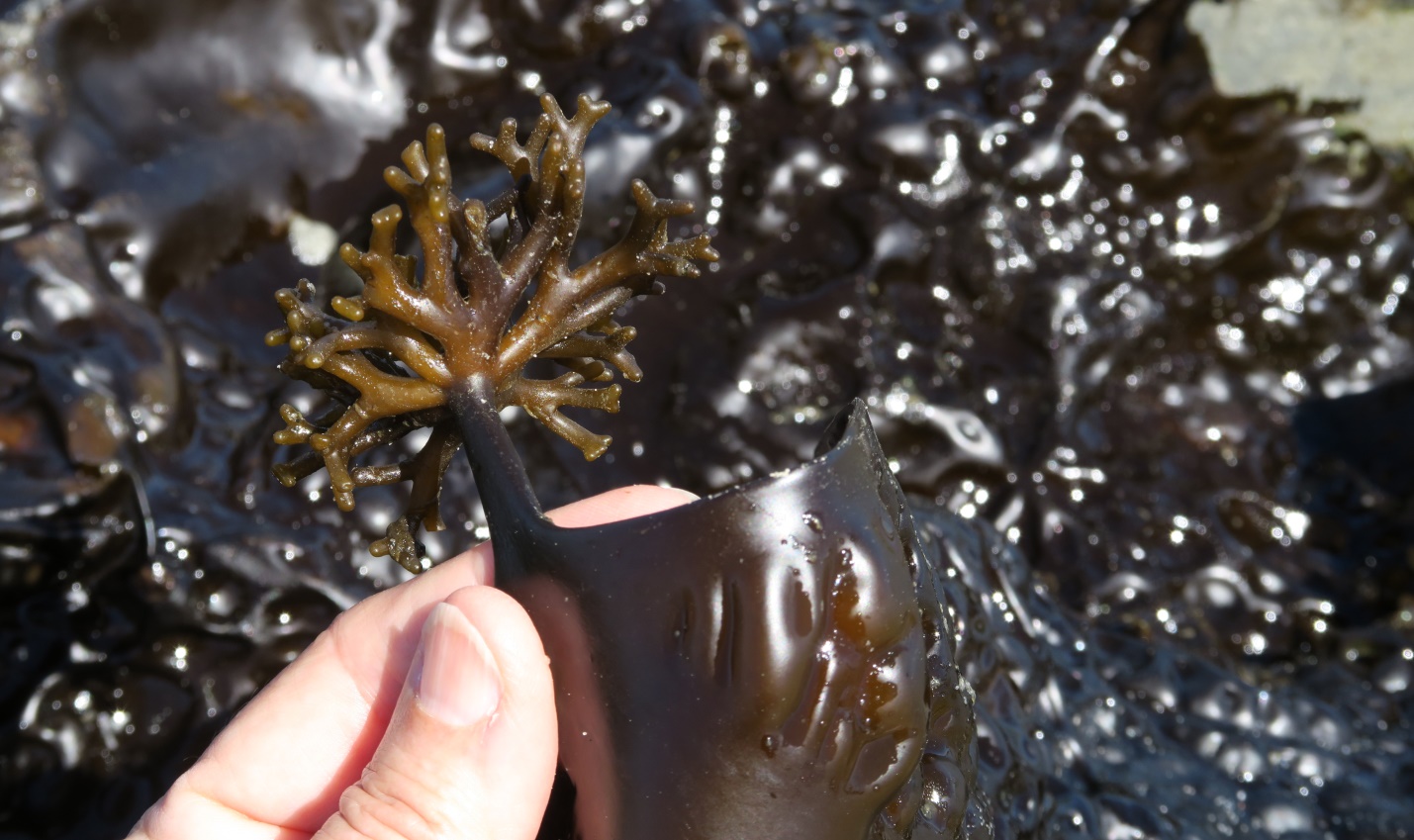
Figure 4: A holdfast that did NOT hold fast; Saccharina latissima. Kye Bay, Strait of Georgia, B.C., Canada. June 26, 2021. Photo ID 27324 ©Seaweedwhisperings.com
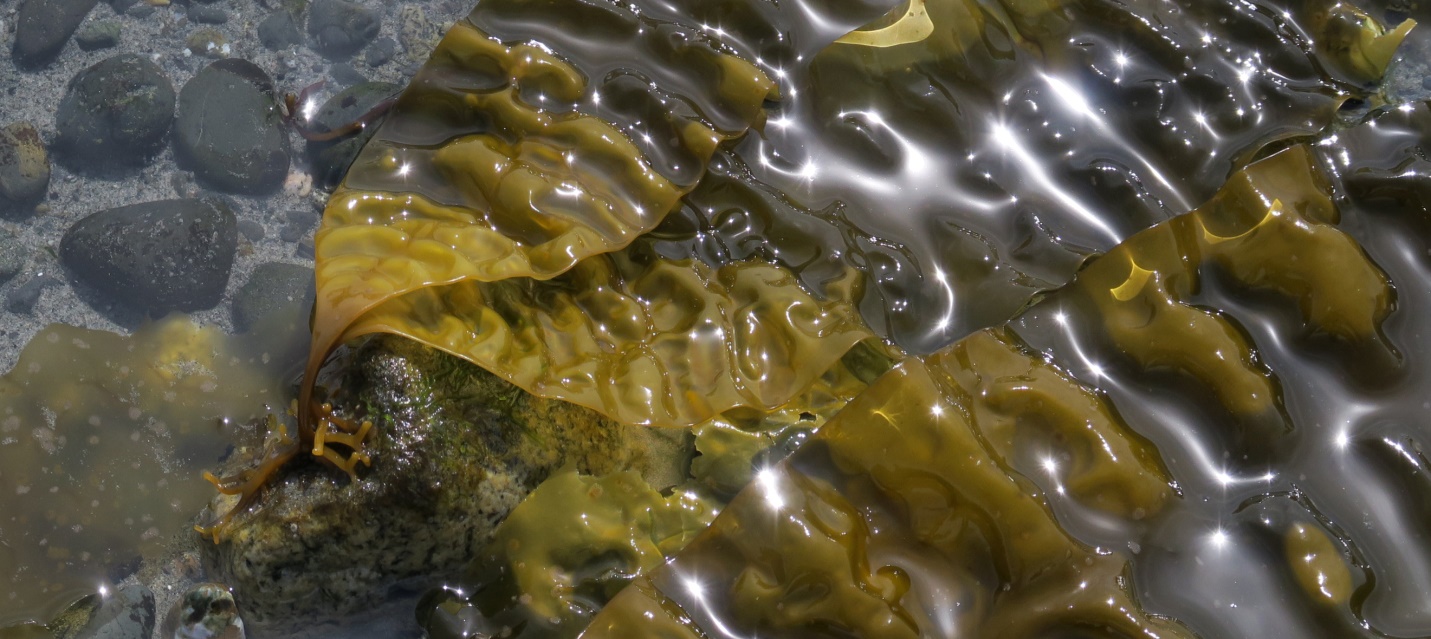
Figure 5: This view of young Sugar Kelp blades shows the finger-like (haptera) of the holdfast; there is something reluctant or tentative looking to the grasp of this holdfast. Little Qualicum Estuary, Strait of Georgia, B.C., Canada. April 29, 2021. Photo ID 27325 ©Seaweedwhisperings.com
Biology & Natural History Information:
Description:
Thallus of this very common kelp is typically an elongated strap-shaped frond that is a light to rich medium brown color. It has a finely branched holdfast (haptera) and from that arise a cylindrical stipe that can be up to 50 cm long. The single blade that grows at the end of the stipe is moderately thick, but can grow to 3.5 meters in length and widths averaging around 20 cm. The blade is undulate and frequently has two rows of bullations (blister-like swellings or puckers) that run along its length; there is no mid rib. This seaweed is tough with a crinkly, dimpled, ruffled appearance. Although this kelp is considered a perennial with the blade dying back each fall/winter and re-growing in the spring, some researchers suggest that is only true of subtidal individuals (that can live up to 3 years) and that intertidal ones are just annuals.
Habitat:
Attaches to rock of the lower intertidal and upper subtidal (to 30 meters); prefers protected to semi-protected habitats. Sugar Kelp colonizes and flourishes on unstable or scoured habitats (sand scoured areas or ones with mobile substrata) and can do well in sheltered areas, also.
Distribution:
Arctic Ocean, Bering Sea and Aleutian Islands, Alaska to Santa Catalina Island, California; Japan; Korea; Russia; North Atlantic, North Sea.
Remarks:
Much research has been conducted on this species notably on the relationship between light levels, temperature and the availability of nutrients on the growth of Sugar Kelp. Young Sugar Kelp are sensitive to high levels of light and so a canopy of adult sporophytes is helpful to provide shade to the younger algae. During low tides the light levels are also much higher which is thought to be why this species cannot grow above the low intertidal zone on shore. In the fall when light levels are declining further growth of Sugar Kelp is not possible even if nutrient levels increase at that time.
With water temperature, it seems Sugar Kelp has a distinct boundary. For example on the east coast of the United States the southern boundary of the range of this kelp is marked by the 19 ˚C summer isotherm. At higher temperatures growth ceases and most sporophytes disappear. Higher temperatures also affect gametophyte formation favoring males over females. Spore formation peaks in the spring and again in the fall, but individuals that form spores in the fall are themselves the offspring of individuals that lived the previous fall and are not the offspring of individuals that formed spores in the spring. Spore release is severely inhibited by pollutants such as petroleum products.
Sugar Kelp is both desirable to herbivores such as sea urchins and snails and also to humans. It contains notable amounts of vitamin C and is high in iodine, protein and calcium.
Classification:
Phylum: Ochrophyta
Class: Phaeophyceae
Order: Laminariales
Family: Laminariaceae
Genus: Saccharina
Species: Saccharina latissima (Linnaeus) C.E.Lane, C.Mayes, Druehl & G.W.Saunders 2006
Former name(s): Laminaria saccharina
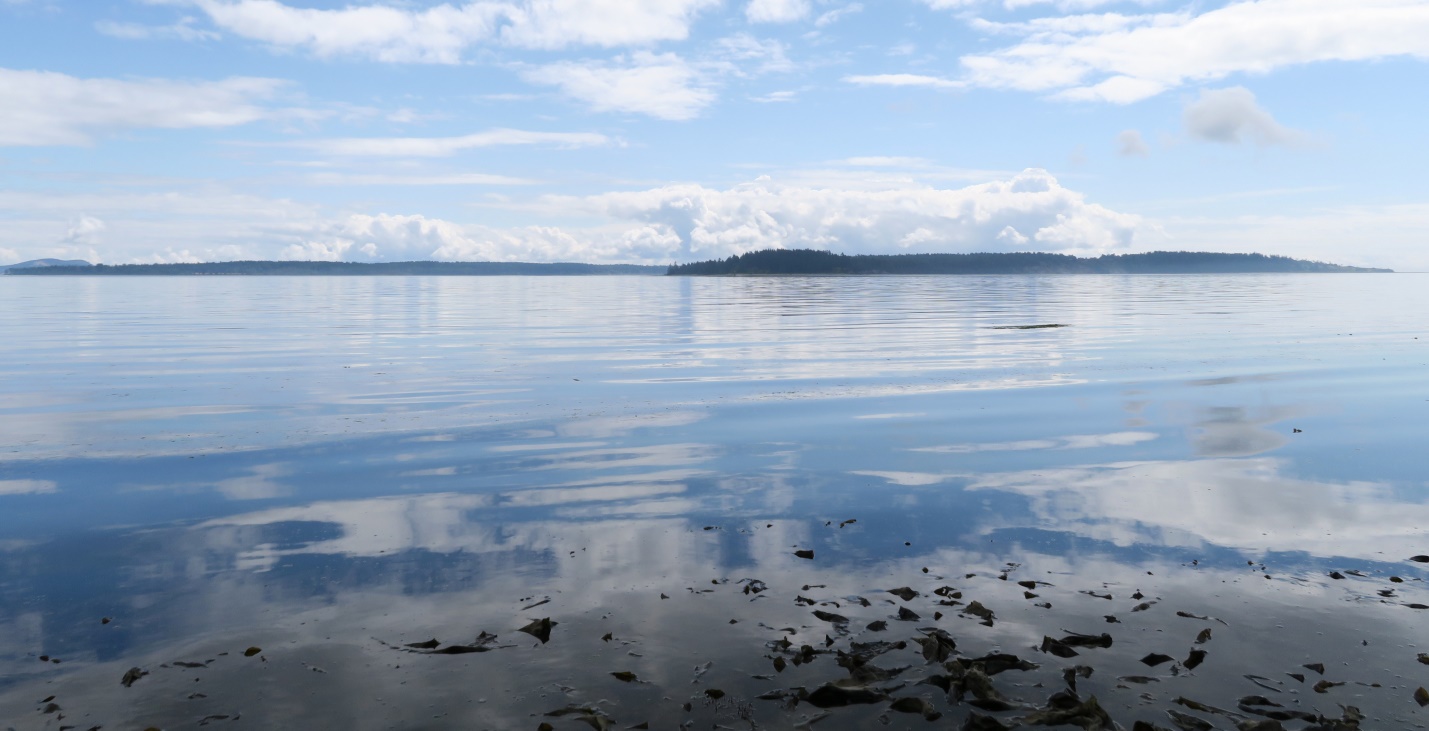
Figure 6: The seaweed that is floating in the foreground on this mirror-calm day is Saccharina latissima. It enjoys semi protected areas such as this at Bazan Bay. Haro Strait, B.C., Canada. July 4, 2020. Photo ID 27326 ©Seaweedwhisperings.com
![]()